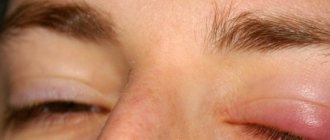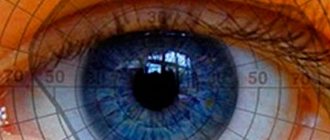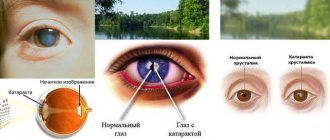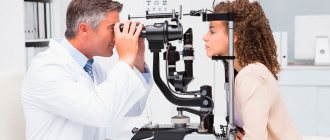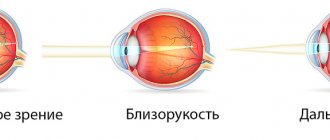Blurry images, spots in front of the eyes, double vision are signs of vision impairment caused by injury or disease, not just the eye. Age and modern lifestyle also have a negative impact on eye health, but even this should not be tolerated.
If your eyes begin to see poorly, you need to seek professional help, because changes in vision that are minor at first get stronger over time and sometimes lead to blindness. Consulting an ophthalmologist will save you from expensive treatment and serious illnesses.
Why does one eye see worse than the other?
If the deterioration of vision is not associated with trauma to the visual organ or other physical damage, then the phenomenon in which poor vision is observed in one eye is called amblyopia. The pathology also has another name, common among the population - “lazy eye”.
With amblyopia, dysfunction of the visual centers is observed, characterized by a disruption in the interaction of the optic nerve of the “lazy eye” with the brain. The corresponding part of the brain does not synchronize signals from both eyes - binocular (volume) vision is impaired.
This happens because the perception of the surrounding world by the “lazy eye” differs from the information provided by the second organ of vision. The brain, in order to create a clear, familiar image, takes the “picture” only from the healthy eye, and ignores the “lazy” one.
Amblyopia is a reversible condition. Sometimes it goes away on its own, in other cases it can be easily treated if you consult an ophthalmologist in a timely manner.
Treatment
Treatment for patients depends on the cause that caused the visual acuity impairment.
The most commonly used methods are:
- selection of corrective lenses or glasses that restore visual acuity;
- physiotherapeutic procedures that improve blood circulation, the condition of nervous tissue, metabolism in the eyeballs;
- laser vision correction, which is a minimally invasive procedure that completely restores visual acuity;
- surgical operations indicated for high myopia and severe astigmatism.
If a patient has a systemic disease that reduces visual function, it is treated first.
Amblyopia - types, causes, who is susceptible
There are different types of amblyopia depending on the cause:
- Dysbinocular amblyopia develops with strabismus.
- Refractive - when you refuse to wear glasses or contact lenses due to myopia, strabismus, as a result of which a blurry image is formed on the retina of one eye.
- Obscurational - inherited.
- Anisometropic - gradually develops if one eye sees a little worse than the other.
- Hysterical - develops with a mental disorder.
Amblyopia is also caused by other pathologies that require medical intervention. To identify them in time, you should consult a doctor and undergo an examination.
According to statistics, people who are predisposed to strabismus are most often susceptible to amblyopia.
With strabismus, different eyes produce different images and send dissimilar information to the brain. The brain does not accept an out-of-focus image and “turns off” the one that is unable to focus on the object.
In addition to strabismus, there are other factors that provoke the development of the symptom:
- heredity;
- eye injury;
- high blood pressure;
- congenital pathologies of the visual apparatus;
- traumatic brain injury;
- problems with blood circulation;
- inflammatory diseases of the organs of vision;
- nerve compression;
- advanced myopia, farsightedness;
- prematurity;
- cerebral paralysis.
The risk group also includes children under 6 years of age, among whom there is a high percentage of people suffering from amblyopia.
Complications
If treatment is not carried out in childhood and adulthood, visual acuity will deteriorate. Without contact lenses or glasses, your eyes will strain to see into the distance. A spasm of accommodation occurs, as a result of which myopia gradually progresses. Astigmatism may develop.
This is a condition in which the eyeball has an irregular shape, causing the surrounding objects to be seen incorrectly by a person.
If a child's vision has deteriorated in only one eye, this may result in exclusion from the function of the other eye. Monocular vision occurs, in which a person is unable to distinguish the distance to an object.
The child has a problem
The baby undergoes the first ophthalmological examination in the first months after birth - visual defects are already detected at this age. However, diagnosing amblyopia in children can be difficult.
It is not common for children to complain about poor eyesight. They tend to adapt to changes, which helps them not notice problems in the body.
If their baby:
- squints;
- turns or tilts his head unnaturally when looking at something;
- watches TV close up;
- complains of a headache when reading or watching TV close up;
- brings the book closer to your face when reading.
These symptoms may indicate that one eye has become less able to see. If you have any suspicions, you should consult an ophthalmologist.
Amblyopia lasting more than 2-3 years can cause deterioration of vision and loss of three-dimensional images: when the image is seen flat, and not in 3D format. And also, as an adult, there is a high probability of refusing laser vision correction.
Symptoms after laser correction
People who have undergone laser vision correction often experience amblyopia in the first months after surgery. Doctors ask not to sound the alarm and assure that amblyopia will go away on its own, without effort on the part of the patient. Visual acuity can change even during the day.
If the patient is not inclined to sit idle, then experts advise performing gymnastics for the “lazy eye.” Doctors advise covering the other (healthy) eye so that the amblyopic eye receives double the load and quickly restores its sharpness.
The condition stabilizes after 3-4 months. Some patients complain of amblyopia for up to six months, but in all cases the phenomenon goes away after 6 months.
What to do at home
If the causes of amblyopia do not threaten your health (and only an ophthalmologist should convince you of this), then it is possible to cope with unpleasant symptoms at home. Placing a bandage on the healthy eye is not an isolated practice. This is done in order to force the “lazy” one to function by increasing the load on it.
The method does not give immediate results - sometimes it takes months to eliminate amblyopia at least partially. In addition, not everyone can wear a headband like a pirate all day.
Experts offer a number of home exercises that help make the “lazy” organ of vision work; while doing them, you should close your eye with good vision:
- Puzzles and mosaics. The smaller the details, the more actively the organ of vision is trained, but you should not immediately take on painstaking work, otherwise you will get tired of it. Start easy and gradually make the task more difficult.
- Coloring pages. Choose not simplified coloring books for children, but images with miniature elements and ornate patterns. A fashion trend is “Anti-stress” coloring books; they will not only help relieve psychological stress, but will also help tone up the “lazy” organ of vision.
- Working with beads, embroidery and knitting. Use multi-colored beads and colored threads - this will create additional stress on the amblyopic eye.
- Chess, checkers, dominoes, backgammon. The game process concentrates attention and requires strengthening of visual function.
- Reading. Start with large font and work your way down to small font.
- Exercises with lines and dots on paper. Trace geometric shapes and outlines of objects along the dotted line. Connect drawn dots into shapes and patterns. When performing exercises, do not lean too low towards the paper.
- Paper modeling. Visual stress forces the weakened eye to work.
- Table tennis. Concentrating on the ball trains the lazy eye.
Exercises can be performed by adults and children, but adults will need more time to restore vision: exercises are more effective at an early age. The main thing is to find something you like, because thanks to sincere interest and passion, you won’t even notice how time flies by.
How to fix the problem
How to fix if one eye sees worse than the other? At the first symptoms, you should contact an ophthalmologist - only he will be able to identify the cause and tell you how to correct your condition. Your doctor may write a prescription for glasses or corrective lenses to ensure good vision in both eyes.
In order to enhance the visual function of the “lazy eye”, an occluder is taken - a patch that covers the healthy organ of vision. Then the brain has no choice but to use the image it receives from the affected eye.
Lately, pleoptic exercises have become popular. They are carried out in specialized clinics. They are performed by an orthoptist - an ophthalmologist who specializes in the treatment of strabismus and amblyopia. The therapy is aimed at improving the perception of color and light stimuli, developing spatial and visual motor orientation.
Your doctor may prescribe atropine drops for a healthy eye. They work on the same principle as an occluder: they disable a healthy organ of vision, blurring the image, and thereby force the affected eye to become active. Another method, photostimulation, is used in the initial stages of the disease.
Photostimulation is the stimulation of the visual organs with bright flashes of light. The rhythm and frequency of these flashes affect not only the visual apparatus, but also the corresponding parts of the brain. The procedure is carried out in specialized clinics.
It is painless and can be performed even on small children - modernized equipment allows this.
Contraindications boil down to intolerance to flashing light, which is observed in patients with epilepsy, brain cancer and mental illness. The average course of treatment is 7-10 sessions.
“Sidorenko glasses” are a revolutionary device that helps improve vision. The essence of his work is to influence the organs of vision with a vacuum massage.
When combined with other therapeutic methods, Sidorenko Glasses help achieve long-term effects. They are prohibited for use by pregnant women, children under 3 years of age, and patients with neurological or mental illnesses.
Causes
The appearance of fog before the eyes is a completely understandable phenomenon and can be triggered by the following factors:
- Clouding of the cornea of the eye . The pathology is caused by inflammatory diseases of the eye, injuries, burns, dystrophy.
- Clouding of the lens . This phenomenon is called cataracts and in most cases is explained by age-related changes in the substance of the eye lens. Cataracts are a particularly common cause of blurred vision in people over 50–60 years of age.
- Retinal disease . Blurred vision can be caused by diabetic and hypertensive retinopathy, chorioretinitis, uveitis, and macular degeneration.
- Pathologies of the optic nerve . Inflammation of the optic nerve at the initial stage is accompanied by a feeling of blurriness of visible objects; this fog is the first symptom of the disease. Then pain occurs when moving the eye.
- Refractive errors. Myopia, farsightedness, and astigmatism are the most common causes of foggy eyes. To eliminate this symptom, correct vision correction with glasses or contact lenses is necessary. Sometimes blurred vision is possible when wearing contact lenses. In this case, you need to consult an ophthalmologist to rule out possible inflammation of the cornea.
- Computer vision syndrome . Working at a computer for a long time and the resulting visual fatigue is often accompanied by complaints of fog in the eyes. This is explained by a spasm of the image-focusing muscle. After sufficient rest, vision is usually restored.
- Instillation of eye drops . Some eye drops cause temporary blurred vision, which is always indicated in the instructions for the drug.
- Secondary cataract . Some time after cataract surgery, a whitish fog may appear in front of the operated eye. It indicates clouding of the lens capsule and is easily removed by laser dissection.
Effective gymnastics for the eyes
Gymnastics improves vision in cases of myopia, farsightedness, and amblyopia. But she can cope with such disorders only as part of complex therapy.
Amblyopia is easiest to treat in children under 6-7 years of age, but the exercises are also recommended for older people. Wearing glasses, using atropine drops and doing exercises, although they do not eliminate the disease, significantly alleviate the condition and inhibit further development.
Exercises for gymnastics:
- Warm up the visual apparatus and prepare it for charging by actively blinking for 10 seconds.
- The first exercise is to rotate the pupils in a circle for 30 seconds in one direction, then in the other.
- Move the icons left and right, then vertically.
- Place your hand on the window glass. Approach your hand at a distance of 10 cm. Move your gaze from your hand to an object outside the window located in the distance. The doctor prescribes this exercise together with the use of drops that expand the icon.
Proper prevention for vision
Deterioration of vision in one eye, either as a temporary phenomenon or as a permanent disease, can actually be prevented if you follow the recommendations of specialists. Simple tips are suitable for everyone, especially for children.
What to do to prevent the development of amblyopia:
- Use moisturizing drops while working at the computer.
- If work involves fixation of vision or excessive strain, take breaks (5 minutes per hour).
- Perform vision exercises daily for at least 2 minutes a day. In order not to forget about it, combine it with brushing your teeth. Teach your children to take care of their eyes no less than other organs!
- Avoid looking at the sun and other bright light sources without sunglasses.
- Properly organize your workplace with sufficient lighting.
- Don't go to bed with makeup on your eyes.
- Visit an ophthalmologist at least once every 2 years.
Astigmatism - blurry vision
You may know that you are nearsighted or farsighted, that is, you see poorly without glasses, but the fact that your vision of both near and distant objects is blurry or distorted is caused not by these problems, but by astigmatism - you don’t even realize until your doctor points it out . Astigmatism is an imperfection in the curvature of the cornea. When the eye is not an ideal spherical shape, and light entering the eye is refracted more in one direction than in the other.
Almost every person can have astigmatism to a small or greater extent, have different types and options for distorting the vision of the picture. And while an adult can highly evaluate their vision, children who have symptoms of astigmatism cannot know that they are seeing something wrong and are unlikely to complain about unclear or distorted vision. Without correction, this vision abnormality can negatively impact a child's ability to achieve in school and sports. This is why it is extremely important that children have regular vision tests to detect astigmatism or other eye problems as early as possible (according to the All About Eyes website - www.vseoglazah.ru).
Causes
Astigmatism is very common. The exact reason for its presence or development in a particular person is not known. People can be born with astigmatism, and this is often the case. A high probability of developing astigmatism is heredity.
Sometimes astigmatism can develop after an eye disease, eye injury, or surgery. Astigmatism cannot develop or get worse from reading in low light conditions or sitting very close to the TV, this is a myth.
Symptoms
Symptoms of astigmatism can vary and depend on the severity of the condition. This:
- blurry vision, blurry picture or part of it,
- eye-strain,
- having to squint to try to see clearly,
- headaches, often pulsating in nature, after intense visual stress, with pain in the eyes and lacrimation;
- fatigue, eye discomfort,
- night blindness - blurred vision at dusk
- Sensitivity to light, accompanied by eye pressure and pain.
Astigmatism may increase over time, but cannot cause other changes in vision: loss of vision, appearance of halos, darkening of the area of vision, external changes in the eye. These are signs of other eye diseases.
Treatment
Treatment for astigmatism is selected individually - read here. If you have any suspicions about the quality of your vision, you should see an ophthalmologist and get checked. Especially if your lifestyle adapts to your visual capabilities. The doctor will evaluate the condition of the eyes and, if astigmatism is present, determine its degree.
- A small degree of astigmatism that a person does not notice and does not cause discomfort is usually not treated.
- The high degree of this disorder with severe symptoms requires a certain approach.
When selecting treatment, the presence of myopia and farsightedness is taken into account. Typically, mild to moderate astigmatism can be corrected with glasses or contact lenses. For some people, refractive surgery may be necessary to correct their vision. Such modern operations are performed with a laser and require certain conditions regarding the condition of the eye, retina, absence of scars and any eye disease. But technology is progressing, and perhaps the list of contraindications will decrease.


